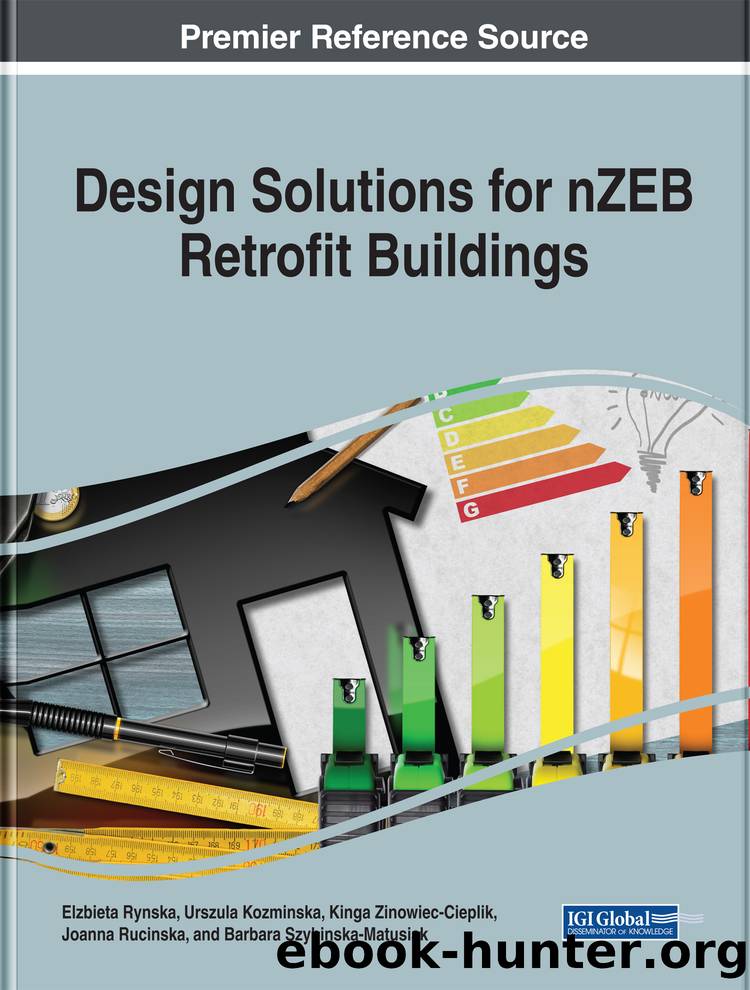Design Solutions for NZEB Retrofit Buildings by Rynska Elzbieta

Author:Rynska, Elzbieta
Language: eng
Format: epub
Publisher: IGI Global
There are many non-technical barriers that have to be overcome in order to achieve energy efficient retrofitting. The first one is skepticism to deep and overall modernization of the building including modernisation of external walls, installation system and also user behaviour. Next one is the owners’ or users’ lack of knowledge about new technologies and about additional benefits coming from increasing building energy performance such as possible improvement of the thermal comfort. (SQARE, KODnZEB)
Before modernisation the building owner should thus increase the knowledge about current user and technical employees’ problems of building (European Parliament's Committee on Industry, Research and Energy (ITRE 2015).
The approach to modernization will be different for one-family houses, residential buildings and office buildings. In single-family buildings, in most cases, users know which measures affect the energy demand. Therefore, owners of single-family homes are more interested to make improvements.
In multifamily houses the modernization process will bring effects when tenants will be involved in the retrofitting process at its early stage. Another aspect is to increase their knowledge about energy saving measures and improvements of the thermal comfort of their flats. In office buildings, users should know how their behaviour affects energy use in building. For this purpose, appropriate training and rules should be provided.
The regulation barriers could also be related to the national legal requirements, such as lack of requirements on energy efficiency for existing buildings or the preference of only standard modernization measures (EU 2050).
Another group is financial barriers. The most common is high costs of realization of a complex retrofitting and the lack of suitable support programs for such investments.
Problems may also occur at the beginning stage of the modernization process. First of them could be lack of innovative design team approach. Another barrier may be lack of technical data on the structure of the building or the restrictions resulting from its construction.
Thermal Comfort
Thermal comfort is the condition of mind that expresses satisfaction with the thermal environment and is assessed by subjective evaluation (ANSI/ASHRAE Standard 55). Maintaining this standard of thermal comfort for occupants of buildings or other enclosures is one of the important goals of HVAC (heating, ventilation, and air conditioning) design engineers.
Improving the energy quality and indoor environmental quality in retrofit buildings requires detailed case study. Modification of the building structure and technical systems only is not sufficient.
Building after modernization should use less energy while still improving the thermal comfort of users. Occupants should feel comfortable. Thermal comfort is difficult to be measured because users may have different needs and preferences. Moreover, it depends on the air temperature, air humidity, radiant temperature, air velocity, metabolic rate and clothing insulation.
Thermal comfort is the occupants’ satisfaction with the surrounding thermal conditions and it must be taken under consideration when designing or modernization a structure that will be used by occupants or employees.
Until recently in the Polish climate the main aspect in energy analysis was to reduce the energy requirement for heating. Therefore, buildings are usually designed to increase the use of sunshine during the heating season.
Download
This site does not store any files on its server. We only index and link to content provided by other sites. Please contact the content providers to delete copyright contents if any and email us, we'll remove relevant links or contents immediately.
Kathy Andrews Collection by Kathy Andrews(11687)
The remains of the day by Kazuo Ishiguro(8757)
Paper Towns by Green John(5030)
Spare by Prince Harry The Duke of Sussex(5004)
The Body: A Guide for Occupants by Bill Bryson(4893)
Industrial Automation from Scratch: A hands-on guide to using sensors, actuators, PLCs, HMIs, and SCADA to automate industrial processes by Olushola Akande(4854)
Machine Learning at Scale with H2O by Gregory Keys | David Whiting(3982)
Be in a Treehouse by Pete Nelson(3881)
Harry Potter and the Goblet Of Fire by J.K. Rowling(3746)
Never by Ken Follett(3712)
Goodbye Paradise(3672)
Into Thin Air by Jon Krakauer(3268)
The Remains of the Day by Kazuo Ishiguro(3260)
The Cellar by Natasha Preston(3225)
The Genius of Japanese Carpentry by Azby Brown(3197)
Fairy Tale by Stephen King(3163)
120 Days of Sodom by Marquis de Sade(3124)
Drawing Shortcuts: Developing Quick Drawing Skills Using Today's Technology by Leggitt Jim(2965)
The Man Who Died Twice by Richard Osman(2963)
